Key takeaways:
- Pro-life advocacy emphasizes the dignity of all human life and focuses on holistic care, empowering women and supporting families through vulnerable moments.
- Community health rights are crucial for improving access to healthcare, fostering environments where everyone feels valued and supported.
- Building coalitions and engaging directly with the community enhances advocacy efforts, emphasizing the power of collective action and storytelling.
- Listening to personal experiences and adapting communication strategies are vital in advocacy, showing that connection and resilience can lead to meaningful change.
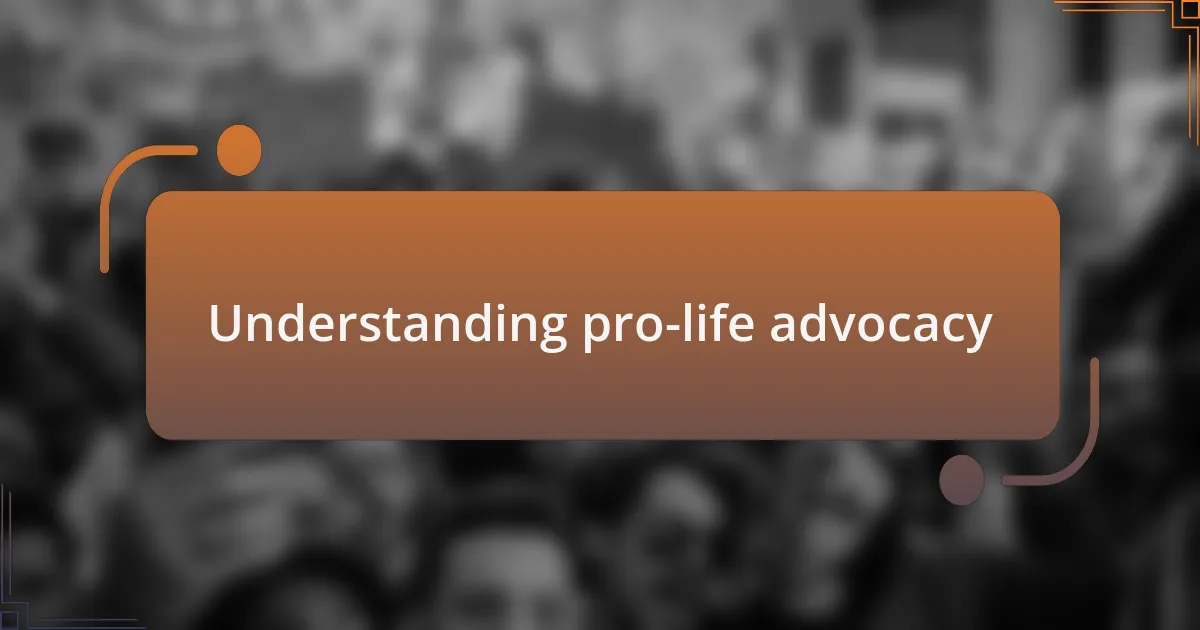
Understanding pro-life advocacy
Pro-life advocacy centers around the belief that every human life, from conception to natural death, has inherent dignity and worth. I often reflect on my conversations with friends who initially saw pro-life as a divisive label, yet through shared stories and statistics, they began to understand it as a movement rooted in compassion and community care. Isn’t it fascinating how personal experiences can shift one’s perspective?
In my own journey, I attended a local rally that opened my eyes to the depth of pro-life advocacy. I met individuals who had faced crises and chose life against overwhelming odds. Hearing their stories made me realize that pro-life isn’t just about policies—it’s about empowering women and supporting families in their most vulnerable moments.
What strikes me the most is the emphasis on holistic care within pro-life advocacy. It’s not enough to speak about the sanctity of life; we must champion the health, resources, and support systems necessary for those facing challenging decisions. How do we encourage a culture that not only values life but also promotes thriving lives? These questions fuel my passion for advocating community health rights alongside the pro-life message.
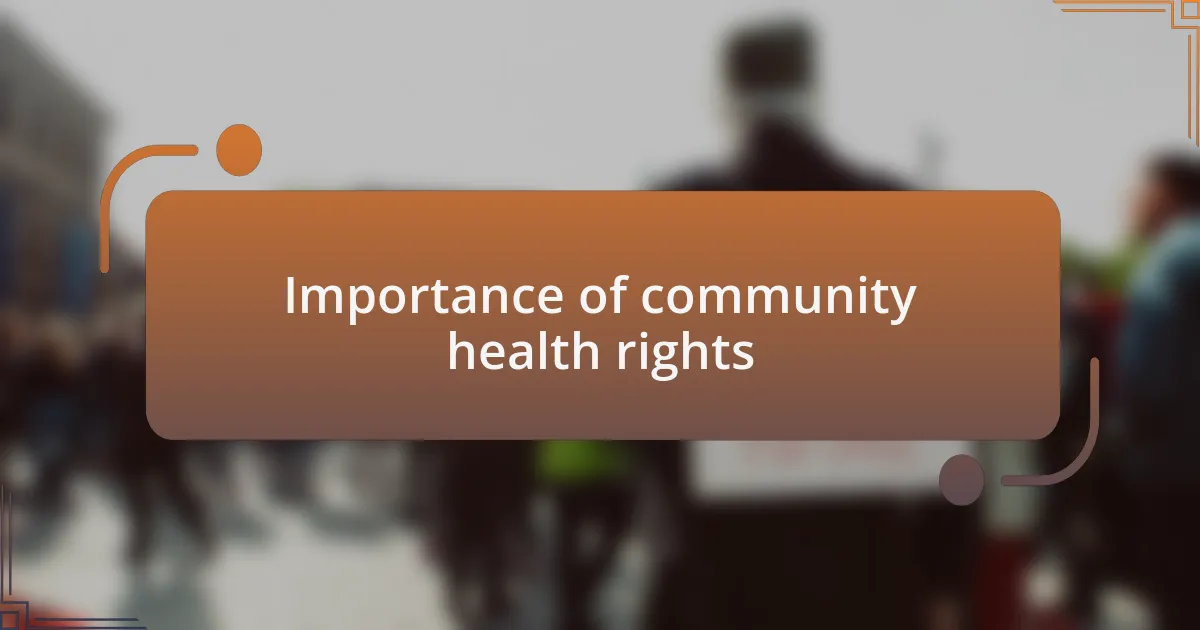
Importance of community health rights
Community health rights play a crucial role in supporting the health and well-being of all individuals, particularly those in vulnerable populations. I’ve seen firsthand how access to quality healthcare can transform lives; during a community health fair, I met a mother who shared her struggle to access prenatal care. Her gratitude for finally receiving the necessary support left a lasting impression on me, highlighting the tangible impact community health rights have on families.
Without robust community health rights, many individuals fall through the cracks. I recall working alongside a grassroots organization, helping to provide health education in underserved neighborhoods. Time and again, I witnessed people feeling empowered when they were informed about their rights and available health services. Isn’t it uplifting to think that knowledge and advocacy can spark hope and change in communities?
The importance of advocating for these rights is not just about access; it’s about fostering an environment where everyone feels valued and cared for. I remember a poignant moment when an elderly gentleman expressed his relief at finally receiving adequate support for his chronic conditions. His words, “I just want to be heard,” resonated deeply with me and underscored the fundamental human right to health. How can we not stand up for those whose voices often go unheard?
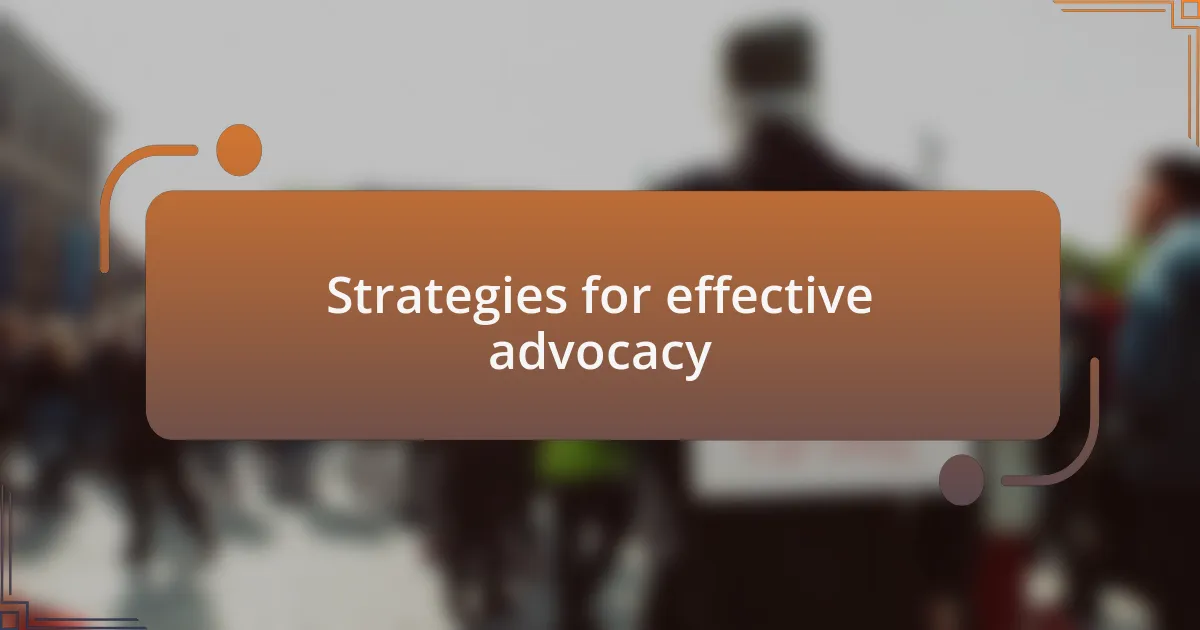
Strategies for effective advocacy
To effectively advocate for community health rights, it’s essential to engage with the community directly. I once volunteered at a local clinic where we organized workshops to educate residents about their health rights. Seeing participants actively ask questions made me realize how critical it is to foster open dialogue. Aren’t conversations like these the heartbeat of meaningful advocacy?
Building coalitions is another powerful strategy. During a campaign for mental health resources, I teamed up with local organizations, which amplified our voices and reach. Witnessing the collective force of diverse groups working together is inspiring. Isn’t it true that when we unite, we can tackle challenges that feel insurmountable as individuals?
Lastly, storytelling can be transformative in advocacy efforts. At a community meeting, I shared my friend’s journey navigating the healthcare system. Her struggles resonated deeply with many attendees, sparking discussions and action plans. Don’t you think narratives like hers can stir compassion and mobilize people to stand up for change?
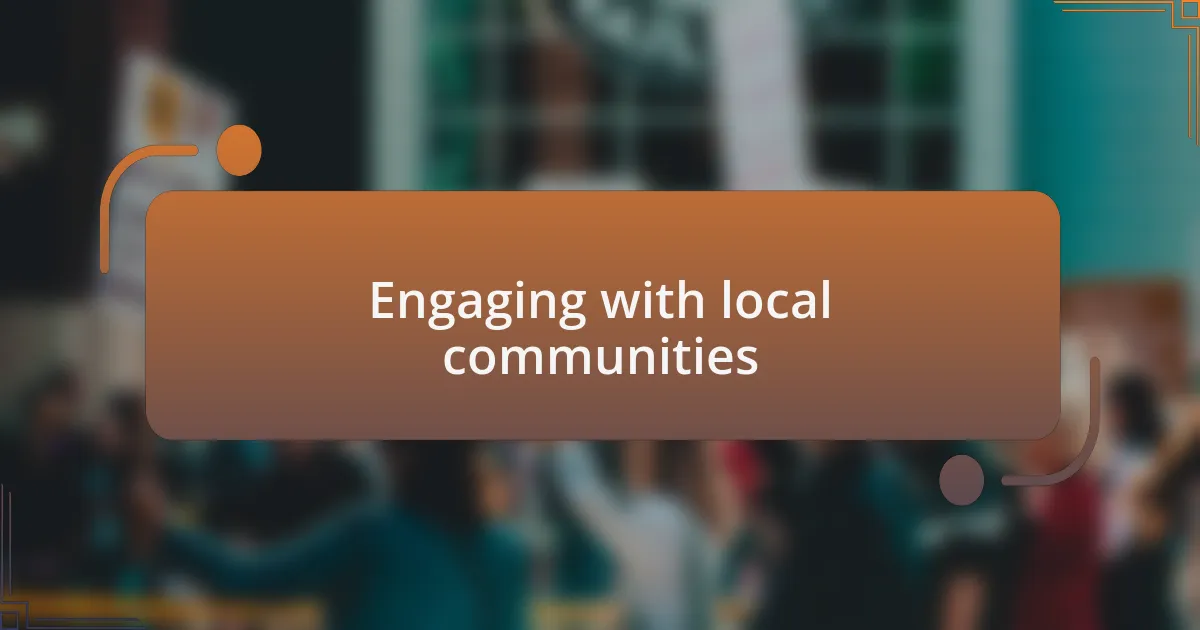
Engaging with local communities
Engaging with local communities starts with active listening. I recall visiting a neighborhood health fair, where I set up a booth to discuss health rights. Many attendees opened up about their personal experiences, sharing frustrations that often went unheard. Isn’t it amazing how simply being present and attentive can help people feel valued and understood?
Another effective approach I discovered is hosting informal gatherings. I organized a coffee chat in my own living room with neighbors to discuss health education barriers. The intimate setting encouraged openness, leading to heartfelt conversations where we brainstormed solutions together. Have you ever experienced how bonding over a warm cup can turn a discussion into a partnership?
Additionally, I found that utilizing local social media groups can significantly enhance engagement. I once posted about an upcoming community health event on a popular platform, which ignited a flurry of comments and questions. It was invigorating to see people rally around a common cause, expressing their eagerness to participate. How rewarding is it to witness a virtual conversation transform into real-world action?
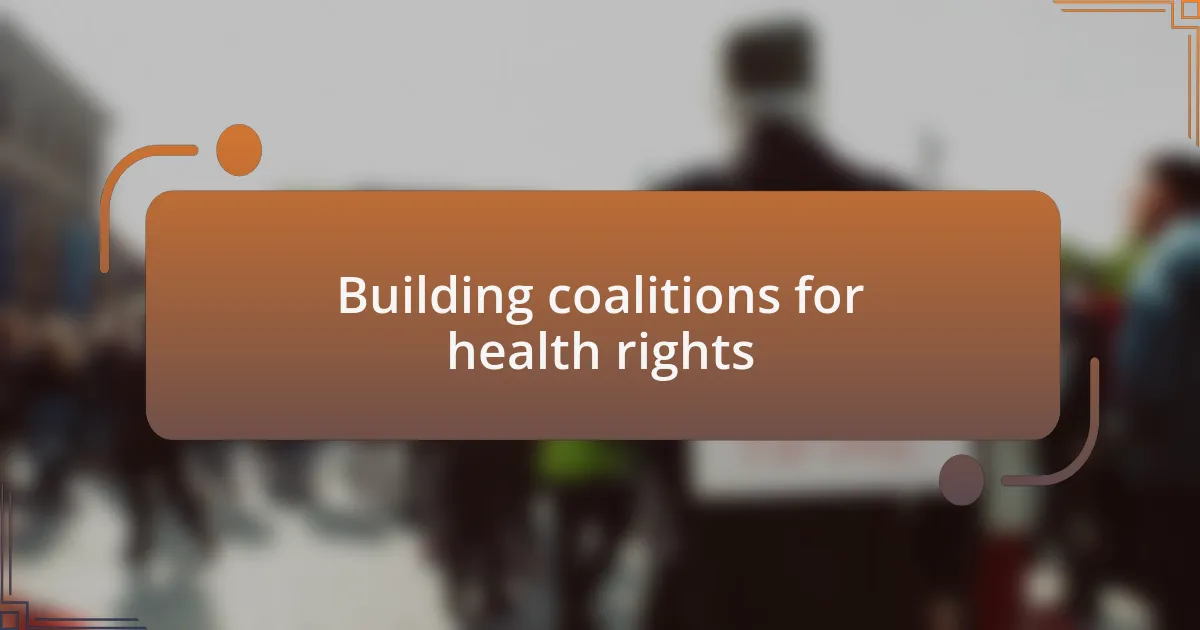
Building coalitions for health rights
Building coalitions for health rights is about recognizing the shared passions within a community. I remember attending a town hall meeting where various organizations came together to discuss health disparities. It was electrifying to see people from different backgrounds unite with a common goal, showcasing that collective voice truly amplifies individual concerns. Have you ever been part of something where you felt the power of unity?
Another approach I found effective involves collaborating with local businesses. For instance, I reached out to a nearby pharmacy to co-organize a health screening event, creating a win-win scenario. Community members not only received valuable health resources, but we also strengthened ties across sectors. Isn’t it fascinating how businesses can champion health initiatives alongside advocacy?
Building relationships with local leaders can also enhance coalition efforts. I had the opportunity to partner with a respected community figure who helped gain trust and credibility in our advocacy work. Their support opened doors we never anticipated, demonstrating that sometimes, all it takes is one influential ally to spark significant movement. How many conversations have you had that changed the trajectory of a cause?
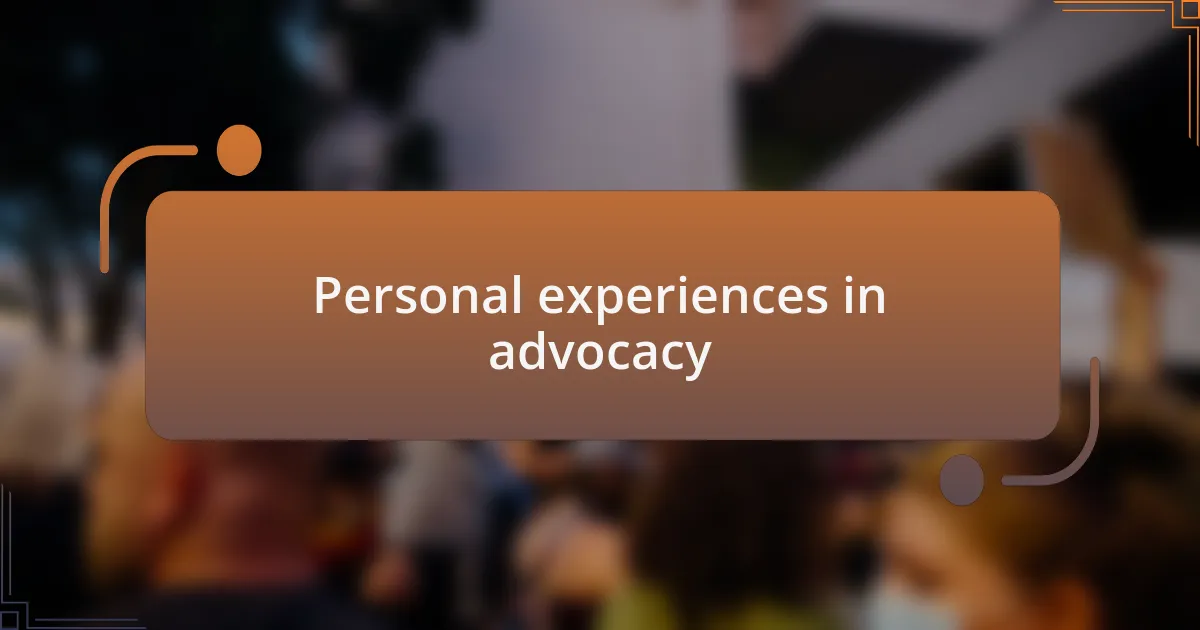
Personal experiences in advocacy
Throughout my advocacy journey, I often find that listening is just as powerful as speaking. One memorable moment was during a community forum where I sat beside individuals sharing their health struggles. Their raw vulnerability struck me deeply, reminding me that every statistic represents a real person. Isn’t it enlightening how these stories can fuel our passion for change?
There was a time when I organized a workshop to educate parents about maternal health. Initially, I was apprehensive, fearing that my knowledge wasn’t enough. However, witnessing the energy in the room as parents engaged and shared their experiences was incredibly fulfilling. It reinforced my belief that advocacy is not only about imparting knowledge but also about creating a space for open dialogue. Have you ever felt that thrill when your efforts resonate so deeply with others?
I distinctly recall a challenging meeting with local policymakers where I presented our community’s health needs. The tension was palpable, and I felt my heart race, but I stood firm in my conviction. When a decision-maker acknowledged our concerns and agreed to consider our proposals, I felt a tremendous weight lift off my shoulders. This experience taught me that persistence in advocacy can lead to meaningful change, but it often comes with its emotional hurdles. How do you overcome those moments of self-doubt in your advocacy efforts?
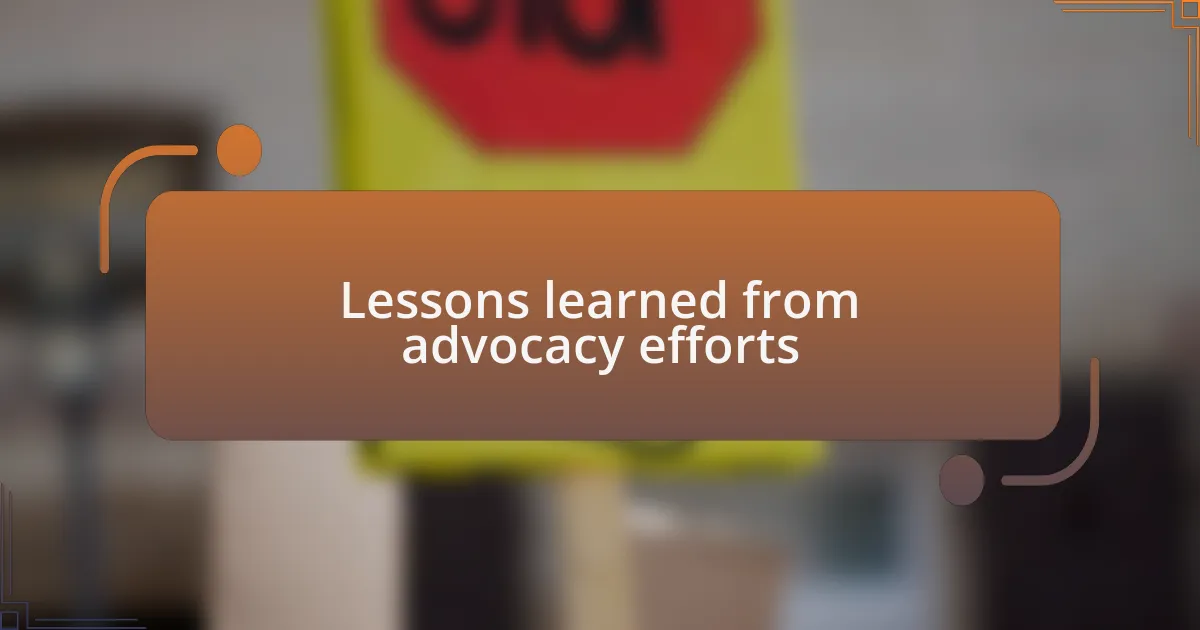
Lessons learned from advocacy efforts
Advocacy is a continuous learning journey, and one pivotal lesson I absorbed is the importance of building coalitions. I once joined forces with a local non-profit organization to address health disparities in our community. This collaboration opened my eyes to the power of diverse perspectives. Have you ever noticed how combining different voices amplifies the message and leads to a more significant impact?
Another significant takeaway was the necessity of adapting my approach based on the audience. I remember delivering a presentation to a group of healthcare professionals, where I initially thought statistics would sway them. Instead, sharing personal stories from community members struck a deeper chord. It made me realize that tailoring my message to resonate with the audience is vital. How can we effectively communicate if we don’t consider who we’re talking to?
Lastly, I learned that setbacks are part of the process. During a campaign for better maternal health resources, I faced several rejections from funding proposals. Each ‘no’ felt like a personal blow, yet they also served as stepping stones. I learned that resilience in advocacy is crucial; it’s about finding new paths when the initial ones don’t work out. In those challenging moments, how do you remind yourself of the bigger picture?